Android 16 bietet tolle neue Funktionen und APIs für Entwickler. In den folgenden Abschnitten werden diese Funktionen zusammengefasst, um Ihnen den Einstieg in die zugehörigen APIs zu erleichtern.
Eine detaillierte Liste der neuen, geänderten und entfernten APIs finden Sie im API-Diffbericht. Details zu neuen APIs finden Sie in der Android API-Referenz. Neue APIs sind hervorgehoben.Sie sollten auch Bereiche prüfen, in denen sich Plattformänderungen auf Ihre Apps auswirken könnten. Weitere Informationen finden Sie auf den folgenden Seiten:
- Verhaltensänderungen, die sich auf Apps auswirken, die auf Android 16 ausgerichtet sind
- Verhaltensänderungen, die sich unabhängig von
targetSdkVersionauf alle Apps auswirken.
Hauptfunktion
Android enthält neue APIs, die die Hauptfunktionen des Android-Systems erweitern.
Zwei Android API-Releases im Jahr 2025
- Diese Vorabversion bezieht sich auf die nächste Hauptversion von Android, die voraussichtlich im 2. Quartal 2025 veröffentlicht wird. Diese Version ähnelt allen unseren API-Releases in der Vergangenheit, bei denen geplante Verhaltensänderungen häufig an eine targetSdkVersion gebunden sind.
- Wir planen die Hauptversion ein Quartal früher (im 2. Quartal statt im 3. Quartal in den Vorjahren), um sie besser an den Zeitplan der Geräteveröffentlichungen in unserem Ökosystem anzupassen. So können mehr Geräte die Hauptversion von Android früher erhalten. Da die Hauptversion im 2. Quartal veröffentlicht wird, müssen Sie die jährlichen Kompatibilitätstests einige Monate früher als in den Vorjahren durchführen, um sicherzustellen, dass Ihre Apps bereit sind.
- Im 4. Quartal 2025 planen wir einen weiteren Release, der auch neue Entwickler-APIs enthalten wird. Die Hauptversion des 2. Quartals ist die einzige Version im Jahr 2025, die geplante Verhaltensänderungen enthält, die sich auf Apps auswirken könnten.
Neben neuen Entwickler-APIs enthält die Nebenversion für das 4. Quartal Funktionsupdates, Optimierungen und Fehlerkorrekturen. Es gibt keine Verhaltensänderungen, die sich auf Apps auswirken.

Es wird weiterhin vierteljährliche Android-Releases geben. Die Updates in den ersten und dritten Quartalen zwischen den API-Releases dienen der kontinuierlichen Qualitätssicherung. Wir arbeiten aktiv mit unseren Gerätepartnern zusammen, um die Version für das zweite Quartal auf möglichst vielen Geräten verfügbar zu machen.
Neue APIs mit Haupt- und Nebenversionen verwenden
Derzeit wird ein Codeblock mit einer Prüfung auf die API-Ebene mit der Konstante SDK_INT und VERSION_CODES geschützt. Diese Funktion wird weiterhin für wichtige Android-Releases unterstützt.
if (SDK_INT >= VERSION_CODES.BAKLAVA) {
// Use APIs introduced in Android 16
}
Die neue Konstante SDK_INT_FULL kann für API-Prüfungen sowohl für Haupt- als auch Nebenversionen mit der neuen Aufzählung VERSION_CODES_FULL verwendet werden.
if (SDK_INT_FULL >= VERSION_CODES_FULL.[MAJOR or MINOR RELEASE]) {
// Use APIs introduced in a major or minor release
}
Sie können auch die Methode Build.getMinorSdkVersion() verwenden, um nur die Nebenversion des SDK abzurufen.
val minorSdkVersion = Build.getMinorSdkVersion(VERSION_CODES_FULL.BAKLAVA)
Diese APIs sind noch nicht fertiggestellt und können sich ändern. Bitte senden Sie uns Feedback, wenn Sie Bedenken haben.
Nutzerfreundlichkeit und System-UI
Android 16 bietet App-Entwicklern und Nutzern mehr Kontrolle und Flexibilität bei der Konfiguration ihres Geräts.
Fortschrittsorientierte Benachrichtigungen
Android 16 introduces progress-centric notifications to help users seamlessly track user-initiated, start-to-end journeys.
Notification.ProgressStyle is a new notification
style that lets you create progress-centric notifications. Key use cases include
rideshare, delivery, and navigation. Within the Notification.ProgressStyle
class, you can denote states and milestones in a user journey using
points and segments.
To learn more, see the Progress-centric notifications documentation page.
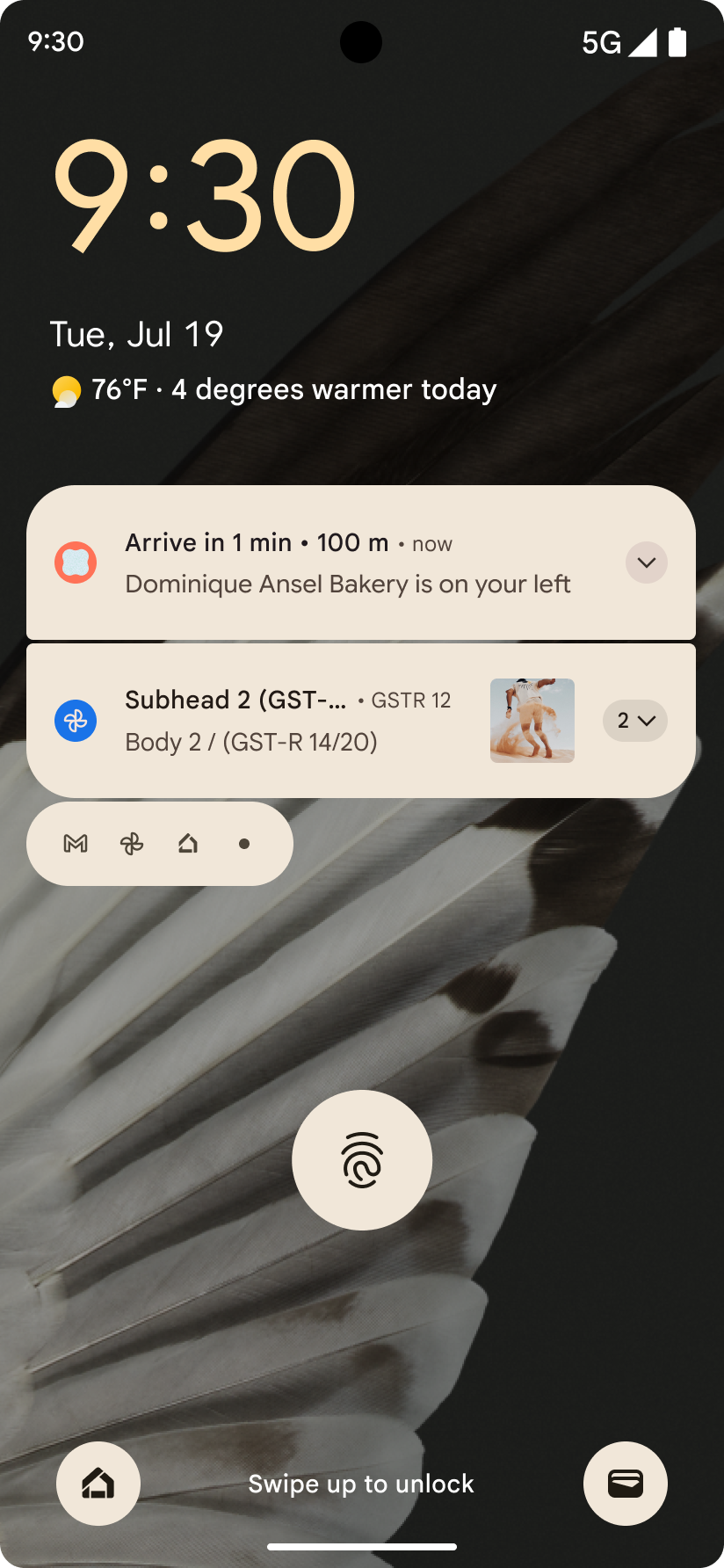
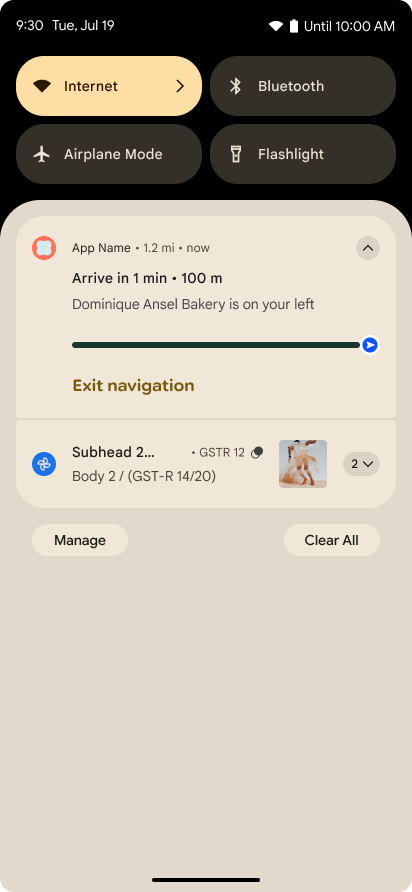
Updates für die intelligente „Zurück“-Geste
Android 16 adds new APIs to help you enable predictive back system animations in
gesture navigation such as the back-to-home animation. Registering the
onBackInvokedCallback with the new
PRIORITY_SYSTEM_NAVIGATION_OBSERVER allows your app to
receive the regular onBackInvoked call whenever the
system handles a back navigation without impacting the normal back navigation
flow.
Android 16 additionally adds the
finishAndRemoveTaskCallback() and
moveTaskToBackCallback. By registering these callbacks
with the OnBackInvokedDispatcher, the system can trigger
specific behaviors and play corresponding ahead-of-time animations when the back
gesture is invoked.
Verbesserte Haptik
Android has exposed control over the haptic actuator ever since its inception.
Android 11 added support for more complex haptic effects that more advanced
actuators could support through
VibrationEffect.Compositions of device-defined semantic
primitives.
Android 16 adds haptic APIs that let apps define the amplitude and frequency curves of a haptic effect while abstracting away differences between device capabilities.
Produktivität und Tools für Entwickler
Der Großteil unserer Arbeit zur Verbesserung Ihrer Produktivität konzentriert sich auf Tools wie Android Studio, Jetpack Compose und die Android Jetpack-Bibliotheken. Wir suchen jedoch immer nach Möglichkeiten auf der Plattform, die Ihnen helfen, Ihre Vision zu verwirklichen.
Umgang mit Inhalten für Live-Hintergründe
In Android 16, the live wallpaper framework is gaining a new content API to
address the challenges of dynamic, user-driven wallpapers. Currently, live
wallpapers incorporating user-provided content require complex, service-specific
implementations. Android 16 introduces
WallpaperDescription and
WallpaperInstance. WallpaperDescription lets you
identify distinct instances of a live wallpaper from the same service. For
example, a wallpaper that has instances on both the home screen and on the lock
screen may have unique content in both places. The wallpaper picker and
WallpaperManager use this metadata to better present
wallpapers to users, streamlining the process for you to create diverse and
personalized live wallpaper experiences.
Leistung und Akku
Mit Android 16 werden APIs eingeführt, mit denen Sie Statistiken zu Ihren Apps erheben können.
Vom System ausgelöstes Profiling
ProfilingManager was
added in Android 15, giving apps the ability to
request profiling data collection using Perfetto on public devices in the field.
However, since this profiling must be started from the app, critical flows such
as startups or ANRs would be difficult or impossible for apps to capture.
To help with this, Android 16 introduces system-triggered profiling to
ProfilingManager. Apps can register interest in receiving traces for certain
triggers such as cold start reportFullyDrawn
or ANRs, and then the system starts and stops a trace on the app's behalf. After
the trace completes, the results are delivered to the app's data directory.
Komponente in ApplicationStartInfo starten
ApplicationStartInfo wurde in Android 15 hinzugefügt. Damit können Apps Gründe für den Prozessstart, den Starttyp, Startzeiten, Drosselungen und andere nützliche Diagnosedaten sehen. In Android 16 wird getStartComponent() hinzugefügt, um zu unterscheiden, welcher Komponententyp den Start ausgelöst hat. Das kann hilfreich sein, um den Startvorgang Ihrer App zu optimieren.
Bessere Selbstreflexion
The JobScheduler#getPendingJobReason() API returns a reason why a job
might be pending. However, a job might be pending for multiple reasons.
In Android 16, we are introducing a new API
JobScheduler#getPendingJobReasons(int jobId), which returns multiple
reasons why a job is pending, due to both explicit constraints set by the
developer and implicit constraints set by the system.
We're also introducing
JobScheduler#getPendingJobReasonsHistory(int jobId), which returns a list
of the most recent constraint changes.
We recommend using the API to help you debug why your jobs may not be executing, especially if you're seeing reduced success rates of certain tasks or have bugs around latency of certain job completion. For example, updating widgets in the background failed to occur or prefetch job failed to be called prior to app start.
This can also better help you understand if certain jobs are not completing due to system defined constraints versus explicitly set constraints.
Adaptive Aktualisierungsrate
Adaptive refresh rate (ARR), introduced in Android 15, enables the display refresh rate on supported hardware to adapt to the content frame rate using discrete VSync steps. This reduces power consumption while eliminating the need for potentially jank-inducing mode-switching.
Android 16 introduces hasArrSupport() and
getSuggestedFrameRate(int) while restoring
getSupportedRefreshRates() to make it easier for your apps to take
advantage of ARR. RecyclerView
1.4 internally supports ARR when it is settling from a fling or
smooth scroll, and we're continuing our work to add ARR
support into more Jetpack libraries. This frame rate article covers
many of the APIs you can use to set the frame rate so that your app can directly
use ARR.
Headroom APIs in ADPF
The SystemHealthManager introduces the
getCpuHeadroom and
getGpuHeadroom APIs, designed to provide games and
resource-intensive apps with estimates of available CPU and GPU resources. These
methods offer a way for you to gauge how your app or game can best improve
system health, particularly when used in conjunction with other Android Dynamic
Performance Framework (ADPF) APIs that detect thermal
throttling.
By using CpuHeadroomParams and
GpuHeadroomParams on supported devices, you can
customize the time window used to compute the headroom and select between
average or minimum resource availability. This can help you reduce your CPU or
GPU resource usage accordingly, leading to better user experiences and improved
battery life.
Bedienungshilfen
Android 16 bietet neue APIs und Funktionen für die Barrierefreiheit, mit denen Sie Ihre App für alle Nutzer zugänglich machen können.
Verbesserte APIs für Bedienungshilfen
Android 16 adds additional APIs to enhance UI semantics that help improve consistency for users that rely on accessibility services, such as TalkBack.
Outline text for maximum text contrast
Users with low vision often have reduced contrast sensitivity, making it challenging to distinguish objects from their backgrounds. To help these users, Android 16 introduces outline text, replacing high contrast text, which draws a larger contrasting area around text to greatly improve legibility.
Android 16 contains new AccessibilityManager APIs to let
your apps check or register a listener to
see if this mode is enabled. This is primarily for UI Toolkits like Compose to
offer a similar visual experience. If you maintain a UI Toolkit library or your
app performs custom text rendering that bypasses the
android.text.Layout class then you can use this to know
when outline text is enabled.
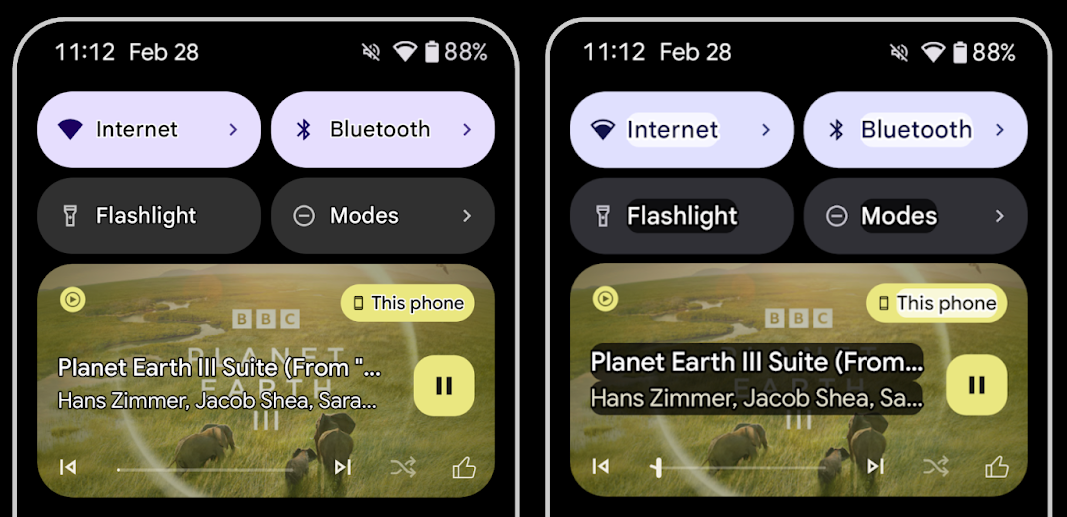
Duration added to TtsSpan
Android 16 extends TtsSpan with a TYPE_DURATION,
consisting of ARG_HOURS, ARG_MINUTES,
and ARG_SECONDS. This lets you directly annotate time
duration, ensuring accurate and consistent text-to-speech output with services
like TalkBack.
Support elements with multiple labels
Android currently allows UI elements to derive their accessibility label from
another, and now offers the ability for multiple labels to be associated, a
common scenario in web content. By introducing a list-based API within
AccessibilityNodeInfo, Android can directly support these
multi-label relationships. As part of this change, we've deprecated
AccessibilityNodeInfo#setLabeledBy and
#getLabeledBy in favor of
#addLabeledBy, #removeLabeledBy, and
#getLabeledByList.
Improved support for expandable elements
Android 16 adds accessibility APIs that allow you to convey the expanded or
collapsed state of interactive elements, such as menus and expandable lists. By
setting the expanded state using setExpandedState and
dispatching TYPE_WINDOW_CONTENT_CHANGED AccessibilityEvents
with a CONTENT_CHANGE_TYPE_EXPANDED content change type,
you can ensure that screen readers like TalkBack announce
state changes, providing a more intuitive and inclusive user experience.
Indeterminate ProgressBars
Android 16 adds RANGE_TYPE_INDETERMINATE, giving a way for
you to expose RangeInfo for both determinate and
indeterminate ProgressBar widgets, allowing services like
TalkBack to more consistently provide feedback for progress
indicators.
Tri-state CheckBox
The new AccessibilityNodeInfo
getChecked and setChecked(int)
methods in Android 16 now support a "partially checked" state in addition to
"checked" and "unchecked." This replaces the deprecated boolean
isChecked and setChecked(boolean).
Supplemental descriptions
When an accessibility service describes a ViewGroup, it
combines content labels from its child views. If you provide a
contentDescription for the ViewGroup, accessibility services assume you are
also overriding the description of non-focusable child views. This can be
problematic if you want to label things like a drop-down (for example, "Font
Family") while preserving the current selection for accessibility (for example,
"Roboto"). Android 16 adds setSupplementalDescription so
you can provide text that provides information about a ViewGroup without
overriding information from its children.
Required form fields
Android 16 adds setFieldRequired to
AccessibilityNodeInfo so apps can tell an accessibility
service that input to a form field is required. This is an important scenario
for users filling out many types of forms, even things as simple as a required
terms and conditions checkbox, helping users to consistently identify and
quickly navigate between required fields.
Smartphone als Mikrofoneingabe für Sprachanrufe mit LEA-Hörgeräten
Android 16 adds the capability for users of LE Audio hearing aids to switch between the built-in microphones on the hearing aids and the microphone on their phone for voice calls. This can be helpful in noisy environments or other situations where the hearing aid's microphones might not perform well.
Lautstärkeregelung für Umgebungsgeräusche für LE Audio-Hörgeräte
Mit Android 16 können Nutzer von LE Audio-Hörgeräten die Lautstärke der Umgebungsgeräusche anpassen, die von den Mikrofonen des Hörgeräts aufgenommen werden. Das kann hilfreich sein, wenn Hintergrundgeräusche zu laut oder zu leise sind.
Kamera
Android 16 bietet erweiterte Unterstützung für Nutzer professioneller Kameras. So ist eine Hybrid-Auto-Belichtung sowie eine präzise Anpassung der Farbtemperatur und des Farbtons möglich. Ein neuer Nachtmodus-Indikator gibt Ihrer App Aufschluss darüber, wann zum und vom Nachtmodus gewechselt werden soll. Mit neuen Intent-Aktionen lassen sich jetzt noch einfacher Bewegungsfotos aufnehmen. Außerdem verbessern wir kontinuierlich Ultra-HDR-Bilder mit Unterstützung der HEIC-Codierung und neuen Parametern aus dem ISO 21496-1-Entwurfsstandard.
Hybride automatische Belichtung
Android 16 adds new hybrid auto-exposure modes to Camera2, allowing you to manually control specific aspects of exposure while letting the auto-exposure (AE) algorithm handle the rest. You can control ISO + AE, and exposure time + AE, providing greater flexibility compared to the current approach where you either have full manual control or rely entirely on auto-exposure.
fun setISOPriority() {
// ... (Your existing code before the snippet) ...
val availablePriorityModes = mStaticInfo.characteristics.get(
CameraCharacteristics.CONTROL_AE_AVAILABLE_PRIORITY_MODES
)
// ... (Your existing code between the snippets) ...
// Turn on AE mode to set priority mode
reqBuilder.set(
CaptureRequest.CONTROL_AE_MODE,
CameraMetadata.CONTROL_AE_MODE_ON
)
reqBuilder.set(
CaptureRequest.CONTROL_AE_PRIORITY_MODE,
CameraMetadata.CONTROL_AE_PRIORITY_MODE_SENSOR_SENSITIVITY_PRIORITY
)
reqBuilder.set(
CaptureRequest.SENSOR_SENSITIVITY,
TEST_SENSITIVITY_VALUE
)
val request: CaptureRequest = reqBuilder.build()
// ... (Your existing code after the snippet) ...
}
Präzise Anpassungen der Farbtemperatur und des Farbtons
Android 16 bietet Kameraunterstützung für die Feinabstimmung von Farbtemperatur und Farbton, um professionelle Videoaufnahmeanwendungen besser zu unterstützen. In früheren Android-Versionen konnten Sie die Weißabgleichseinstellungen über CONTROL_AWB_MODE steuern. Diese Optionen waren auf eine vordefinierte Liste beschränkt, z. B. Glühlampen, Bedeckt und Dämmerung. Mit der Taste COLOR_CORRECTION_MODE_CCT können Sie COLOR_CORRECTION_COLOR_TEMPERATURE und COLOR_CORRECTION_COLOR_TINT verwenden, um den Weißabgleich basierend auf der korrespondierenden Farbtemperatur präzise anzupassen.
public void setCCT() {
...
Range<Integer> colorTemperatureRange =
mStaticInfo.getCharacteristics().get(CameraCharacteristics.
COLOR_CORRECTION_COLOR_TEMPERATURE_RANGE);
// Set to manual mode to enable CCT mode
reqBuilder.set(CaptureRequest.CONTROL_AWB_MODE, CameraMetadata.CONTROL_AWB_MODE_OFF);
reqBuilder.set(CaptureRequest.COLOR_CORRECTION_MODE,
CameraMetadata.COLOR_CORRECTION_MODE_CCT);
reqBuilder.set(CaptureRequest.COLOR_CORRECTION_COLOR_TEMPERATURE, 5000);
reqBuilder.set(CaptureRequest.COLOR_CORRECTION_COLOR_TINT, 30);
CaptureRequest request = reqBuilder.build();
...
}
Die folgenden Beispiele zeigen, wie ein Foto aussehen würde, nachdem verschiedene Anpassungen der Farbtemperatur und des Farbtons vorgenommen wurden:
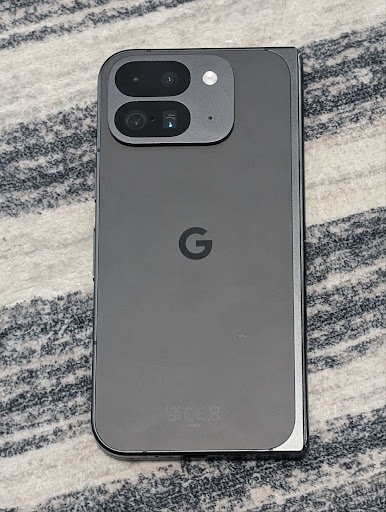
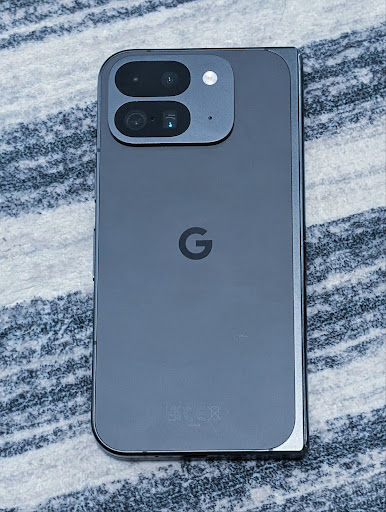

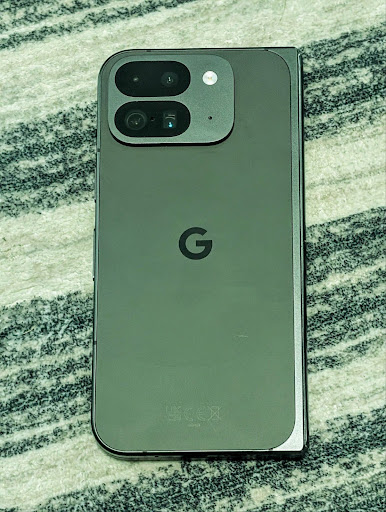

Szenenerkennung im Nachtmodus der Kamera
To help your app know when to switch to and from a night mode camera session,
Android 16 adds EXTENSION_NIGHT_MODE_INDICATOR. If
supported, it's available in the CaptureResult within
Camera2.
This is the API we briefly mentioned as coming soon in the How Instagram enabled users to take stunning low light photos blog post. That post is a practical guide on how to implement night mode together with a case study that links higher-quality in-app night mode photos with an increase in the number of photos shared from the in-app camera.
Intent-Aktionen für Fotos mit Bewegtbild
Android 16 adds standard Intent actions —
ACTION_MOTION_PHOTO_CAPTURE, and
ACTION_MOTION_PHOTO_CAPTURE_SECURE — which request that
the camera application capture a motion photo and return
it.
You must either pass an extra EXTRA_OUTPUT to control
where the image will be written, or a Uri through
Intent.setClipData(ClipData). If you don't set a
ClipData, it will be copied there for you when calling
Context.startActivity(Intent).
UltraHDR-Bildoptimierung
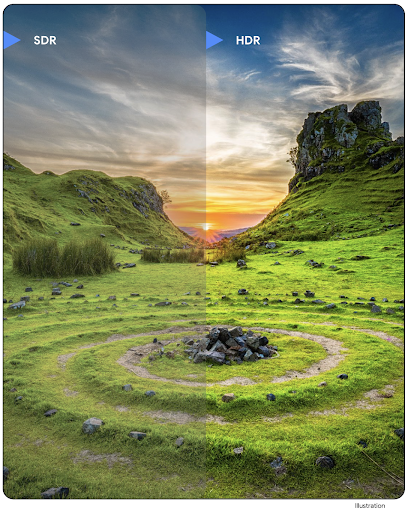
Android 16 continues our work to deliver dazzling image quality with UltraHDR
images. It adds support for UltraHDR images in the HEIC file
format. These images will get ImageFormat type
HEIC_ULTRAHDR and will contain an embedded gainmap similar
to the existing UltraHDR JPEG format. We're working on AVIF support for UltraHDR
as well, so stay tuned.
In addition, Android 16 implements additional parameters in UltraHDR from the ISO 21496-1 draft standard, including the ability to get and set the colorspace that gainmap math should be applied in, as well as support for HDR encoded base images with SDR gainmaps.
Grafik
Android 16 enthält die neuesten Grafikverbesserungen, z. B. benutzerdefinierte Grafikeffekte mit AGSL.
Benutzerdefinierte grafische Effekte mit AGSL
Android 16 adds RuntimeColorFilter and
RuntimeXfermode, allowing you to author complex effects like
Threshold, Sepia, and Hue Saturation and apply them to draw calls. Since Android
13, you've been able to use AGSL to create custom
RuntimeShaders that extend Shader. The new API
mirrors this, adding an AGSL-powered RuntimeColorFilter that
extends ColorFilter, and a Xfermode effect that
lets you implement AGSL-based custom compositing and blending between source and
destination pixels.
private val thresholdEffectString = """
uniform half threshold;
half4 main(half4 c) {
half luminosity = dot(c.rgb, half3(0.2126, 0.7152, 0.0722));
half bw = step(threshold, luminosity);
return bw.xxx1 * c.a;
}"""
fun setCustomColorFilter(paint: Paint) {
val filter = RuntimeColorFilter(thresholdEffectString)
filter.setFloatUniform(0.5);
paint.colorFilter = filter
}
Konnektivität
Mit Android 16 wird die Plattform aktualisiert, damit Ihre App auf die neuesten Fortschritte in der Kommunikation und drahtlosen Technologien zugreifen kann.
Abtasten mit erweiterter Sicherheit
Android 16 unterstützt robuste Sicherheitsfunktionen für die WLAN-Standortermittlung auf unterstützten Geräten mit 802.11az von Wi‑Fi 6. So können Apps die höhere Genauigkeit, die größere Skalierbarkeit und die dynamische Planung des Protokolls mit Sicherheitsverbesserungen wie AES-256-basierter Verschlüsselung und Schutz vor MITM-Angriffen kombinieren. So kann es sicherer in Anwendungsfällen mit Näherungserkennung verwendet werden, z. B. zum Entsperren eines Laptops oder einer Fahrzeugtür. 802.11az ist in den Wi‑Fi 6-Standard integriert und nutzt dessen Infrastruktur und Funktionen für eine breitere Akzeptanz und einfachere Bereitstellung.
Generische APIs für die Entfernungsmessung
Android 16 includes the new RangingManager, which provides
ways to determine the distance and angle on supported hardware between the local
device and a remote device. RangingManager supports the usage of a variety of
ranging technologies such as BLE channel sounding, BLE RSSI-based ranging, Ultra
Wideband, and Wi-Fi round trip time.
Gerätepräsenz des Begleitgerätemanagers
In Android 16, new APIs are being introduced for binding your companion app
service. Service will be bound when BLE is in range and Bluetooth is connected
and service will be unbound when BLE is out of range or Bluetooth is
disconnected. App will receives a new
'onDevicePresenceEvent()' callback based on various
of DevicePresenceEvent.
More details can be found in
'startObservingDevicePresence(ObservingDevicePresenceRequest)'.
Medien
Android 16 bietet eine Vielzahl von Funktionen, die die Mediennutzung verbessern.
Verbesserte Bildauswahl
The photo picker provides a safe, built-in way for users to grant your app access to selected images and videos from both local and cloud storage, instead of their entire media library. Using a combination of Modular System Components through Google System Updates and Google Play services, it's supported back to Android 4.4 (API level 19). Integration requires just a few lines of code with the associated Android Jetpack library.
Android 16 includes the following improvements to the photo picker:
- Embedded photo picker: New APIs that enable apps to embed the photo picker into their view hierarchy. This allows it to feel like a more integrated part of the app while still leveraging the process isolation that allows users to select media without the app needing overly broad permissions. To maximize compatibility across platform versions and simplify your integration, you'll want to use the forthcoming Android Jetpack library if you want to integrate the embedded photo picker.
- Cloud search in photo picker: New APIs that enable searching from the cloud media provider for the Android photo picker. Search functionality in the photo picker is coming soon.
Erweiterte Videoanzeigen für Professionals
Android 16 introduces support for the Advanced Professional Video (APV) codec which is designed to be used for professional level high quality video recording and post production.
The APV codec standard has the following features:
- Perceptually lossless video quality (close to raw video quality)
- Low complexity and high throughput intra-frame-only coding (without pixel domain prediction) to better support editing workflows
- Support for high bit-rate range up to a few Gbps for 2K, 4K and 8K resolution content, enabled by a lightweight entropy coding scheme
- Frame tiling for immersive content and for enabling parallel encoding and decoding
- Support for various chroma sampling formats and bit-depths
- Support for multiple decoding and re-encoding without severe visual quality degradation
- Support multi-view video and auxiliary video like depth, alpha, and preview
- Support for HDR10/10+ and user-defined metadata
A reference implementation of APV is provided through the OpenAPV project. Android 16 will implement support for the APV 422-10 Profile that provides YUV 422 color sampling along with 10-bit encoding and for target bitrates of up to 2Gbps.
Datenschutz
Android 16 bietet eine Vielzahl von Funktionen, mit denen App-Entwickler den Datenschutz der Nutzer schützen können.
Health Connect-Updates
Health Connect in the developer preview adds ACTIVITY_INTENSITY, a new
data type defined according to World Health Organization guidelines around
moderate and vigorous activity. Each record requires the start time, the end
time and whether the activity intensity is moderate or vigorous.
Health Connect also contains updated APIs supporting health records. This allows apps to read and write medical records in FHIR format with explicit user consent. This API is in an early access program. If you'd like to participate, sign up to be part of our early access program.
Privacy Sandbox für Android
Android 16 incorporates the latest version of the Privacy Sandbox on Android, part of our ongoing work to develop technologies where users know their privacy is protected. Our website has more about the Privacy Sandbox on Android developer beta program to help you get started. Check out the SDK Runtime which allows SDKs to run in a dedicated runtime environment separate from the app they are serving, providing stronger safeguards around user data collection and sharing.
Sicherheit
Android 16 bietet Funktionen, mit denen Sie die Sicherheit Ihrer App und die Daten Ihrer App schützen können.
API zur Schlüsselfreigabe
Android 16 adds APIs that support sharing access to
Android Keystore keys with other apps. The new
KeyStoreManager class supports
granting and revoking access to keys
by app uid, and includes an API for apps to access shared
keys.
Formfaktoren von Geräten
Android 16 bietet Ihren Apps die Unterstützung, die Sie benötigen, um die Formfaktoren von Android optimal zu nutzen.
Standardisiertes Rahmenwerk für Bild- und Audioqualität für Fernseher
The new MediaQuality
package in Android 16 exposes
a set of standardized APIs for access to audio and picture profiles and
hardware-related settings. This allows streaming apps to query profiles and
apply them to media dynamically:
- Movies mastered with a wider dynamic range require greater color accuracy to see subtle details in shadows and adjust to ambient light, so a profile that prefers color accuracy over brightness may be appropriate.
- Live sporting events are often mastered with a narrow dynamic range, but are often watched in daylight, so a profile that preferences brightness over color accuracy can give better results.
- Fully interactive content wants minimal processing to reduce latency, and wants higher frame rates, which is why many TV's ship with a game profile.
The API allows apps to switch between profiles and users to enjoy tuning supported TVs to best suit their content.
Lokalisierung
Android 16 bietet Funktionen, die die Nutzerfreundlichkeit verbessern, wenn ein Gerät in verschiedenen Sprachen verwendet wird.
Vertikaler Text
Android 16 adds low-level support for rendering and measuring text vertically to
provide foundational vertical writing support for library developers. This is
particularly useful for languages like Japanese that commonly use vertical
writing systems. A new flag,
VERTICAL_TEXT_FLAG,
has been added to the Paint class. When
this flag is set using
Paint.setFlags, Paint's
text measurement APIs will report vertical advances instead of horizontal
advances, and Canvas will draw text
vertically.
val text = "「春は、曙。」"
Box(
Modifier.padding(innerPadding).background(Color.White).fillMaxSize().drawWithContent {
drawIntoCanvas { canvas ->
val paint = Paint().apply { textSize = 64.sp.toPx() }
// Draw text vertically
paint.flags = paint.flags or VERTICAL_TEXT_FLAG
val height = paint.measureText(text)
canvas.nativeCanvas.drawText(
text,
0,
text.length,
size.width / 2,
(size.height - height) / 2,
paint
)
}
}
) {}
Einheitensystem anpassen
Users can now customize their measurement system in regional preferences within
Settings. The user preference is included as part of the locale code, so you can
register a BroadcastReceiver on
ACTION_LOCALE_CHANGED to handle locale configuration changes when
regional preferences change.
Using formatters can help match the local experience. For example, "0.5 in" in English (United States), is "12,7 mm" for a user who has set their phone to English (Denmark) or who uses their phone in English (United States) with the metric system as the measurement system preference.
To find these settings, open the Settings app and navigate to System > Languages & region.

